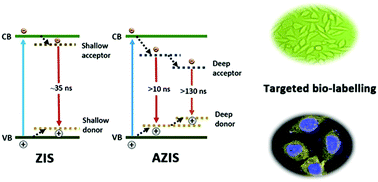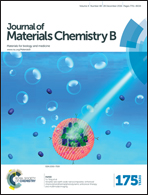Tumor cell-targeted Zn3In2S6 and Ag–Zn–In–S quantum dots for color adjustable luminophores†
Abstract
We present a hydrothermal approach for the preparation of biocompatible and high-quality Zn3In2S6 (ZIS) quantum dots (QDs) in the presence of glutathione (GSH) as a stabilizer at different reaction temperatures. The as-prepared QDs exhibited small particle diameters (from 3.3 to 7.5 nm) with a hexagonal structure and size-dependent optical properties. The combination of the pH value and the amount of GSH played a crucial role in the enhancement of PL intensity. After the incorporation of Ag via cation exchange, the obtained Ag–Zn–In–S (AZIS) QDs demonstrated both red-shifted photo-luminescence (PL) emission and higher quantum yield. Furthermore, based on the investigations of PL lifetimes and excitation intensity-dependent PL spectra, we concluded that PL emission of ZIS QDs originated from shallow donor–acceptor (D–A) pair recombination, and intrinsic trap state-related deep D–A pair transition dominated the main emission of AZIS QDs. Furthermore, the biocompatible AZIS QDs with high quantum yield were applied to targeted labeling and imaging in the cytoplasm of hepatocellular carcinoma cells, indicating their promising applications in single-cell monitoring.


 Please wait while we load your content...
Please wait while we load your content...